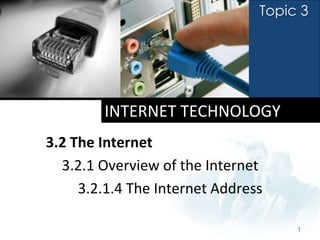
2.2.1.4 internet address amrizah
- 1. Topic 3 INTERNET TECHNOLOGY 3.2 The Internet 3.2.1 Overview of the Internet 3.2.1.4 The Internet Address 1
- 2. Learning Outcome At the end of this topic, students should be able to: • Identify the structure of IP Address. • Describe the purpose of an IP Address and its relationship to a domain name. 2
- 3. Internet Address What is an IP Address? • An IP address (Internet Protocol address) is a number that uniquely identifies each computer or device connected to the Internet. Why does an IP Address exist? • It exists as the Internet relies on an addressing system much like the postal service to send data and information to a computer at a specific destination. Note: No two machine have the same IP address. 3
- 4. Internet Address What does an IP Address consist of? • The IP address consists of four groups of numbers, each separated by a period that uniquely identifies (address of network and specific device). The number in each group is between 0 and 255. • In other words, IP address are 32-bit numbers, written in dotted decimal notation. Each 4 bytes is written in decimal format between 0 to 255. The lowest IP address : 0.0.0.0 The highest IP address : 255.255.255.255 Examples of IP address : 72.14.207.99 4
- 5. Internet Address How does an IP Address look like? • A typical IP address looks like this: 216.27.61.137 • To make it easier for us humans to remember, IP address is expressed in decimal format as a "dotted decimal number" like the one above. • In general, the first portion of each IP address identifies the network and the last portion identifies the specific computer. 5
- 6. Internet Address • But remember, computers communicate in binary form. Look at the same IP address in binary: 11011000.00011011.00111101.10001001 • If you add all the positions together, you get 32, which is why IP address is considered 32-bit numbers. • Since IP address is difficult to remember and use. Thus, the Internet supports the use of a text name that represents one or more IP addresses. 6
- 7. Example IP Adress 0.0.0.0 (default network) 127.0.0.1 (for testing as a loopback address) 255.255.255.255 (network broadcast) Special reserved 10.0.0.0 to 10.255.255.255 addresses (private networks) 172.16.0.0 to 172.31.255.255 (private networks) 192.168.0.0 to 192.168.255.255 (private networks)
- 8. Domain Name What is a Domain Name? • A domain name is the text version of an IP address. • As with an IP address, the components of a domain name are separated by periods. IP address 72.14.207.99 Domain name www.google.com top-level domain The IP address and domain name for the Google Web site 8
- 9. Domain Name • Every domain name contains a top-level domain (TLD), which is the last section of the domain name. • A generic TLD (gTLD), identifies the type of organization associated with the domain. • In the domain name www.google.com, the top-level domain is .com 9
- 10. Domain Name A generic top-level domain (gTLD) is one of the categories of top- level domains (TLDs) maintained by the Internet Assigned Numbers Authority (IANA) for use in the Domain Name System(DNS) of the Internet. generic Domain Top-level Top-level name domain domain system (TLD) (gTLD) (DNS) The last section of Identifies the type translates the the domain name of organization domain name into associated with its associated IP the domain address.
- 11. Domain Name • The organization that assigns and controls top-level domains is the Internet Corporation for Assigned Names and Numbers (ICANN pronounced EYE-can). • The domain name system (DNS) is the method that the Internet uses to store domain names and their corresponding IP addresses. 11
- 12. Domain Name • When you specify a domain name, a DNS server translates the domain name to its associated IP address so that data and information can be routed to the correct computer. • A DNS server is an Internet server that usually is associated with an Internet service provider. 12
- 13. Domain Name Examples Examples of Generic Top-Level Domains Generic TLD Intended Purpose aero Aviation community members biz Businesses of all sizes cat Catalan cultural community com Commercial organizations, businesses, and companies coop Business cooperatives such as credit unions and rural electric co-ops edu Educational institutions gov Government agencies info Business organizations or individuals providing general information jobs Employment or human resource businesses mil Military organizations mobi Delivery and management of mobile Internet services museum Accredited museums name Individuals or families net Network providers or commercial companies org Nonprofit organizations pro Certified professionals such as doctors, lawyers, and accountants tel Internet communications travel Travel industry 13
- 14. Internet Address Protocol The protocol of the Internet is called TCP/IP (Transmission Control Protocol/Internet Protocol) . TCP/IP – allowing cross-network communication for almost every type of computer and network. The protocol that provides for addressing and routing IP Internet packets from one (Internet Protocol) computer to another
- 15. Internet Address Protocol TCP protocol – defines a system similar in many ways to the postal system. A message that sent on the Internet is broken into packets. Each packet has all the information routers need to transfer the packet from network to network towards it destination. IP – defines the addressing system of the Internet. Every host computer on the Internet has a unique IP address
- 16. IPv4 IPv6 Version 6 of Version 4 of Internet Protocol, Internet Protocol, has more capabilities the most widely than IPv4, including used version of IP providing for far more IP address